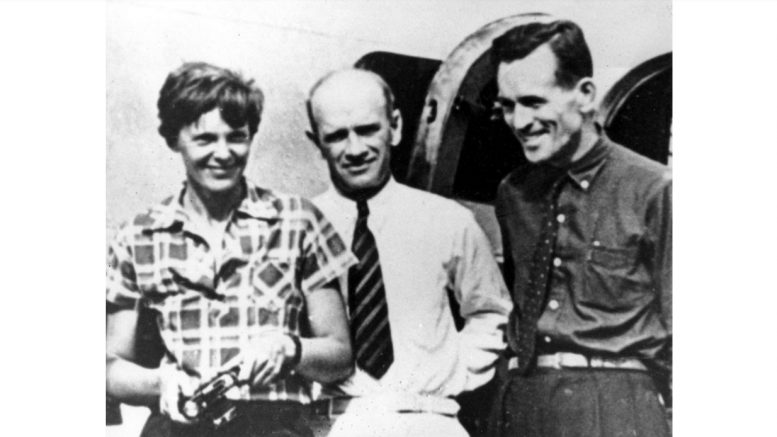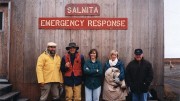The following is an extract from the newly published coffee table book A History: Placer Development Limited and Placer Dome Inc. compiled by Nean Allman and Justin Baulch, and available at www.aplacerdomehistory.com.
_______________________
The disappearance of Amelia Earhart and navigator Fred Noonan in 1937 on an attempted round-the-world flight has become one of aviation history’s great enigmas, embroidered with fanciful theories about their fate and the subject of at least 30 books, says an article by Hugh Leggatt in the June 1992 issue of Placer Dome’s employee quarterly, Prospect.
“At a time when aircraft exploits gripped the popular imagination the way space travel would do to a later generation, Amelia Earhart was the first woman to attempt to fly around the world and the first person to try to do so around the equator. She was already the first woman to fly solo across the Atlantic Ocean and she held other aviation records.”

A dredge at Placer Development Corp.’s gold Bulolo gold operations in New Guinea in the 1930s. Credit: Placer Dome.
The story of her disappearance en route to Howland Island is relatively well known. What is not so well known is that the two aviators flew off on the last leg of their tragic journey from Lae in New Guinea, from the airport that owed its existence to the Bulolo goldfields.
The Earhart flight, in a Lockheed Electra, began in Oakland, California, and went first to Miami in Florida, then to South America, Africa, India, Java and Darwin, Australia. It arrived at Lae on June 29, 1937. Among those who greeted the famous pair were Louis J. Joubert, manager of Bulolo Gold Dredging Limited, and Mrs. Joubert, fellow Americans who flew from Bulolo with Tommie O’Dea of Guinea Airways to meet the travelers.
The aviators’ plan after Lae was to refuel at Howland Island, fly on to Hawaii and then return to Oakland from Honolulu. Howland Island is on the equator, 2,500 miles from Lae and over half way to Honolulu. The flight was estimated to take about 18 hours. Earhart and Noonan left Lae at 10 a.m. on July 2, their aircraft laden with fuel sufficient for 23 hours of flying – and were never seen again.

Unloading a Junkers aircraft at Placer Development Corp.’s Bulolo gold operation in New Guinea in the 1930s. Credit: Placer Dome.
The first third of the flight went as planned. The Lae operator received the last of three reports at 5.18 p.m. Later that night a radio station on the island of Nauru heard a report, while a crewman on a freighter putting into port at Nauru heard the plane pass overhead. The last signal was heard by the US Coastguard cutter Itasca, standing by off Howland Island. Earhart was “running on line” which means flying north and south on a north-south line in order to locate a pinpoint destination.
According to a reconstruction of the flight from Lae by The International Group of Historic Aircraft Recovery (TIGHAR), the aircraft’s disappearance was probably the result of a combination of navigation and wireless problems. It is speculated that when less than 100 miles from Howland Island they turned south instead of north, and ran out of fuel before retracing their flight path.
TIGHAR has suggested that the plane ditched on a reef at Gardner Island, and eventually was washed off the reef into deep water offshore. Gardner Island is now called Nikumaroro, and forms part of the Republic of Kiribati, previously known as the Gilbert Islands.
 TIGHAR’s conclusions were aided unexpectedly by the discovery of a file marked “Bulolo Gold Dredging, Ltd./Amelia Earhart” in Placer Dome’s basement storage in Vancouver about 1991. The file contained a report for the U.S. Bureau of Air Commerce written by Eric Chater, General Manager of Guinea Airways at Lae, three weeks after Earhart’s disappearance.
TIGHAR’s conclusions were aided unexpectedly by the discovery of a file marked “Bulolo Gold Dredging, Ltd./Amelia Earhart” in Placer Dome’s basement storage in Vancouver about 1991. The file contained a report for the U.S. Bureau of Air Commerce written by Eric Chater, General Manager of Guinea Airways at Lae, three weeks after Earhart’s disappearance.
It was written after the Bureau asked Frank Griffin, a Placer Development director in San Francisco, for any “information of interest relative to Miss Earhart’s visit and flight,” and Griffin cabled Chater for help.
Of particular interest to TIGHAR were the confirmation of the fuel load carried, and the fact that Earhart made an unsuccessful attempt to test her radio direction finder prior to that flight.
“We greatly appreciate Placer Dome’s generosity in making it [Chater’s report] available,” TIGHAR said.
The Chater report is available in its entirety at: http://tighar.org/Projects/Earhart/Archives/Documents/Chater_Report.html
Postscript: In 2012, TIGHAR organized a $2.2 million expedition to Nikumaroro Island that involved a high-tech deep-water search. A sonar image taken near the northwestern shore of the island may indicate the wreckage of a wing or part of the fuselage from the plane. TIGHAR believes Earhart and Noonan landed on a reef surrounding the island and the plane was later washed off the reef into deeper waters, possibly in parts. Previous expeditions have suggested that the two survived for some time on the island but ultimately succumbed.
— Check out our Northern Miner Podcast interview with Nean Allman at www.northernminer.com




A unique combination of Amelia Earhart and gold mining. I look forward to reading Nean’s book.
I am a locals of Bulolo ND VERY INTEREST OF READING NEAN’S BOOK AND THE DISAPPEARING OF AMELIA EARTHART’S BOOK ALSO.